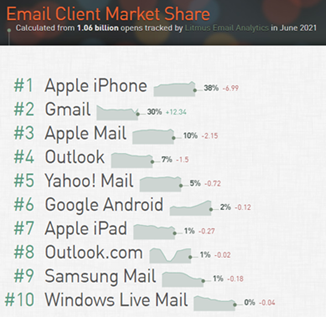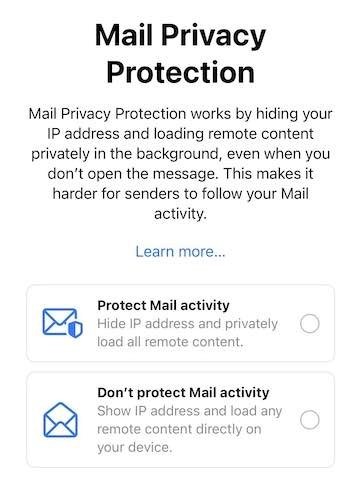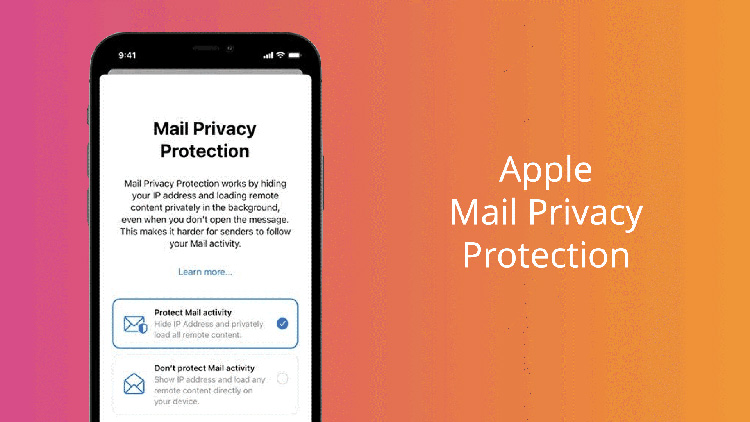Blog
CATEGORY: iOS15 Q&A
iOS15 Q&A

How will Apple's latest release impact email marketing?
In this article we have pulled together all the key questions that we are being asked about how iOS 15 is going to impact the email marketing community.
While changes in email marketing strategy over the next few months are inevitable - in nearly every event that has forced our industry to challenge our current "best practices" - we have increased the quality of our marketing strategies – just think about the impact of GDPR. iOS 15 will be no different - it is an opportunity to further hone our craft.
So, here's what you need to know.
What is Apple Mail Privacy Protection?
Apple announced Mail Privacy Protection for their Mail app on iOS 15, iPadOS 15, and macOS Monterey devices. According to Apple, “Mail Privacy Protection stops senders from using invisible pixels to collect information about the user. [It prevents] senders from knowing when they open an email and masks their IP address so it can’t be linked to other online activity or used to determine their location.”
Check out Apple announces the end of email tracking for more detail.
When is the iOS 15 happening?
Apple have announced that iOS 15 will be released from 20th September and the Privacy Protection will be part of the initial release. With many Apple devices set to update to the latest operating system, the volume of devices with Mail Privacy Protection available will scale quickly.
How big will the impact be?
In Sparkpost’s 2021 Benchmark Report, they saw 38.1% of all opens and clicks coming from one of the Apple Mail app clients, with 25.7% on iPhone, 9.6% on desktop and 2.8% on iPad. This is second only to Gmail (on mobile and desktop) as the largest market share of any device/client family. The below graphic from Litmus echoes this assertion.

However, despite Apple’s market dominance, depending on your sector or business, this may not be replicated in your own databases. So the key thing here is to assess the impact that it will have on your specific communications strategy.
Do Apple mail users have to ‘turn on’ Mail Privacy Protection?
Yes, when someone first opens the Apple Mail app, they’ll get a message prompting them to either “Protect Mail activity” or “Don’t protect Mail activity.” So, this will not be turned on by default. People will have to actively make a choice.

However, when a similar choice was given in iOS 14 for asking apps not to track activity, it is understood that the percentage take-up of the protection mechanism was in the high 90s.
This is not a setting that can be ignored. Everyone who installs iOS 15 will be prompted to make a choice.
How will iOS 15 affect open tracking?
When someone selects the “Protect Mail activity” option, here’s what will happen:
Apple will first route emails through a proxy server to pre-load message content—including tracking pixels—before serving to readers. This will happen, even if readers don’t actually open those emails. This means almost all emails sent to recipients using the Apple Mail app will record as having opened the email, even if they have not.
If the subscriber actually opens the email, it triggers a request to download and display the email’s images (including the e-shot tracking pixel), but instead of coming from the original image host (usually e-shot or your website), they will be loaded from the Apple cache.
Will open rates be higher or lower with iOS 15?
Based on beta testing and Apple's published information on Mail Privacy Protection, open rates will most likely be inflated by it:
"[...], rather than downloading remote content when you open an email, Mail Privacy Protection downloads remote content in the background by default - regardless of how you do or don't engage with the email."
From everything we understand at the moment, Apple Mail will act like a concierge for Apple Mail users, “opening” their mail for them, regardless of what the users end up doing with those emails. To the sender, it will appear that 100% of the recipients have opened those emails.
Email open tracking has become an increasingly complex area because of developments in cybersecurity. The prevalence of Apple Mail will likely make open tracking and analytics based on them highly inaccurate.
There have also been reports that emails Apple identify as Junk will not automatically download images. This will need to be verified in more detail in due course, but could still offer ways to identify disengaged contacts using Apple devices.
Will iOS 15 Mail Privacy Protection affect Gmail or Outlook users?
Mail Privacy Protection will impact any mailbox that uses the Apple Mail app.
Apple Mail is the default Mail application on iPhones, iPads and Macs. Although major services like Gmail and Outlook offer their own iOS apps, many users set up their Gmail or Outlook inboxes using the Apple Mail app instead as this is a default part of device setup. Indeed, many users will run several mailboxes in the same app.
Does it affect all mail opened on Apple devices or just in the native mail app?
Email opened by other apps on iOS 15 or MacOS Monterey will not be affected by Mail Privacy Protection.
It will still be the case that genuine opens will still be recorded when users access their mailboxes on other devices and apps in addition to Apple Mail.
Therefore, the user agent recorded for opens should offer better insight into opens that are real.
What about clicks? Will click reporting be affected by iOS 15?
Mail Privacy Protection will not impact how email clicks are tracked and reported, however there are other aspects of iOS 15 that will.
Those who pay Apple for iCloud will be upgraded to iCloud+ this Autumn. iCloud+ includes a private relay service that will route browsing activity on iOS via an encrypted route using multiple proxy servers.
When configuring Private Relay, the user is presented with two options for protecting their location information. The user can choose to have an anonymous IP address that preserves the user’s approximate location or they can choose to have an IP address that will be located in a broader region. This essentially means that you could choose to show the approximate location as the town/city or simply the country where you reside.
And for all you techies out there: According to Sparkpost’s research, early testing indicates that Apple will not modify the querystring nor are they changing the user agent string. So, first-party click tracking will likely not be impacted by this feature.
In short, the click will be registered but the specifics of geographical location for example will not be known.
“Creating an audience segment of “real openers” now will allow you to continue to use opens to create better emails.” Chad White, Author of Email Marketing Rules
How can I check engagement if opens aren’t real?
How do you measure engagement without open rates? Make ‘clicks’ your number one metric.
Think about how you can elicit the click in your engagement campaign. Here is a great example from Litmus doing just that:
A Re-engagement sequence is to attempt to re-engage inactive subscribers and highlight the subscribers you should cull from your list.
There will still be a portion of your contact list that you can review in terms of open rate – so just as you previously had to be sceptical over whether a Microsoft Outlook recipient may have read and engaged with your email in the preview pane or without downloading images (to activate the tracking pixel),be with Apple device/mail users you now have to be sceptical on the positive report of an open.
Should I resend emails to non-openers?
The tactic of resending a campaign to those who did not register an open is not recommended. Those using Apple Mail will most likely be excluded anyway, but this practice has also been associated with higher levels of spam complaints, so is generally not a good idea.
How will iOS 15 affect my deliverability?
Tracking opens has been a useful way of measuring engagement in email marketing and that engagement data has, in turn, helped email marketers to maintain good deliverability through taking action with disengaged contacts. iOS 15 will make this more difficult to track.
However, emails that are classed as Junk by Apple do not download the images automatically, so iOS 15 may actually give deliverability experts a new way of measuring inbox placement at a subscriber level.
How can I measure my email activity?
The same way you always should have been – clicks!
Open rates have always had a margin for error. Apple is very publicly and deliberately obfuscating real opens with iOS 15, but Microsoft has been doing it in a more basic way by blocking the automatic download of images for years.
Rather than measuring the results of a specific campaign, it is reasonable to expect engaged subscribers to click on at least one link over the course of a few weeks or months, depending on your email frequency.
How will this affect email list hygiene?
Emails sent to those who opt into the new changes will show up in your database as ‘opened’. This can make users on your list appear more engaged than they actually are.
Opens (and the lack-thereof) have long been an important leading indicator of user disengagement which promoted early removal/retargeting of disengaged users.
As a consequence, more of your emails could end up in spam and more users may hit the unsubscribe button due to the lack of relevant content in their inbox.
How do I keep my database from being diluted with disposable email addresses?
Another feature available to iCloud+ users is “hide my email”. This feature enables users with subscriptions to iCloud+ to create single-use email addresses connected to their personal email accounts. As an example, people may offer their single-use email addresses in exchange for a lead magnet.
From investigations done by the Mailcharts geeks, their preliminary findings suggest that these disposable email address will have certain things in common. For example the domain will be @icloud.com and usually contains the number 0. They suggest prior to the iOS 15 launch to do a baseline count on all emails that you have in your database that contain these features so that you have it available to compare once the roll-out has begun.
What other potential problems does iOS 15 create for email marketing?
Send time optimisation will be flawed as it will only reflect the point that the email is cached by Apple rather than when the recipient opens the message.
Subject line testing will be flawed - however if your contact database is large enough to get viable results from other contacts, then now may be the time to create your “control test” segment for use once iOS 15 is operational.
Open-time personalisation/live content won't work, again as a result of the caching.
Countdown timers won't work, also due to the caching.
Can’t use automation flows based on opens (and given that marketers tend to have these as rule- triggered flows rather than ‘managing’ the data that flows through them – a “zero tolerance” policy needs to be taken to ensure that any contact progressing through the flow receives a positive experience.
Is there any future-proof game plan that marketers must follow?
There are a number of things that you can do now to prepare for the shift. In terms of if these actions are future proof – in an evolving story nothing is ever future proof. Whilst Apple may well be sharing its plans for the release and we can draw our conclusions from the details they have shared, how ESPs, deliverability experts and email marketing specialists will respond is yet to be seen. Further actions and insights will become apparent over the coming months as a direct result of their responses.
In the meantime, here are some areas to start addressing:
1. Assess the portion of your audience affected - How much of your audience uses Apple Mail to read your emails? And can you capture data now for which client segments use the Apple Mail app most? If it's low, fingers crossed, then the update might only have negligible impact on your program! In which case, you will still have enough data from other mail apps to provide statistically accurate data for running your campaigns.
2. Clean your audience lists - Clean up your lead quality, list hygiene and sender reputation, since you may not be able to rely on opens anymore as a sign of a deliverability problem. And consider creating audience segments and cohorts that rely on open data so you can keep on using them, at least in the near future. And as above, review the number of @icloud email addresses already in your database, but remember, it will affect other addresses too.
3. Test, test and test again! - If you do not already have a solid handle on what engages your email list and drives desired actions best, test as much creative and messaging variations as possible to solidify your audience understanding. Break it down to audience-segment level so you have data to guide future campaign design in place of recent openers.
4. Avoid knee-jerk reactions - Just like for paid media, the worst thing you can do right now is completely shift your email marketing strategy. Stay calm and carry on with a proven customer acquisition strategy. There is still time to adapt. And as marketers, we have proven that we are a very adaptable sort! Keep assessing workarounds and alternative data quality strategies. For example, collecting higher quality client information in targeted form-fills or during the lead prospecting process, improved database design and more regular data auditing.
How is e-shot adapting to the changes in iOS 15?
We have updated several aspects of e-shot to help us monitor for Apple devices, so that we can get statistically valid data once iOS 15 comes into widespread use.
A new Deliverability Dashboard is also being launched to help customers monitor other signals around engagement.
The big question is whether we exclude opens from our engagement calculations and we will be consulting with customers about what changes we make to reports like this as more concrete data becomes available.
Solutions
Email marketing healthcheck
We are confident that we can help you, which is why we offer a free healthcheck to identify potential issues with your current programme and free advice on things that could be done to improve it.


